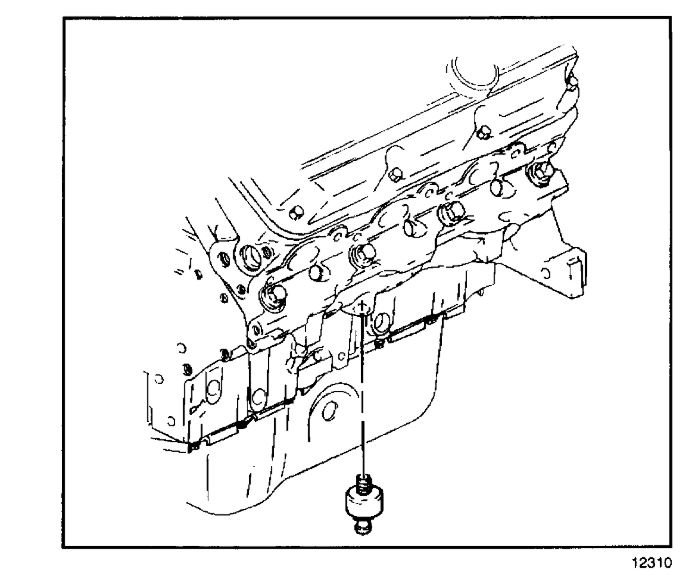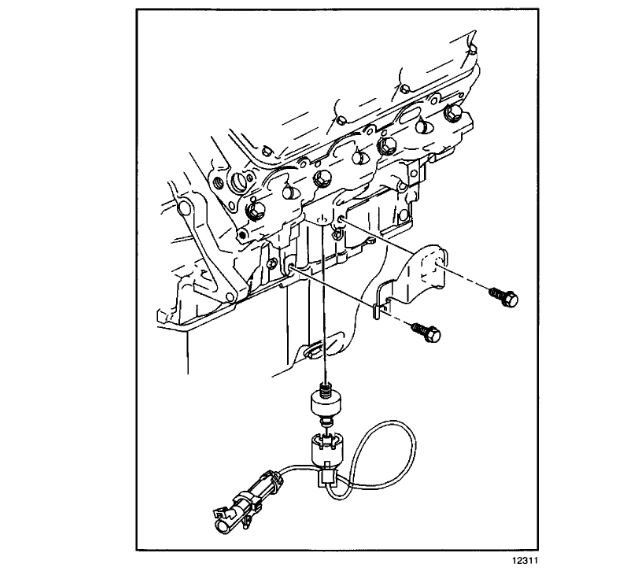Good morning.
The knock sensor is a common failure. This needs to be confirmed before assuming it is the issue.
I attached a description and procedure for replacing it if it is the failure. You need an advanced scan tool to monitor the action of the sensor.
As far as price, the labor is 2 hours at a shop plus the cost of the part. I would also replace the pig tail as well as that is always recommended.
Roy
332
CIRCUIT DESCRIPTION
The Knock Sensors (KS) produce an AC signal under all engine operating conditions. The Powertrain Control Module (PCM) calculates the average voltage range of each KS signal. If the KS system is operating normally, the PCM should monitor the KS voltage varying above and below a calculated average voltage. If the PCM detects a KS 1 signal voltage or a KS 2 voltage signal within the calculated average voltage range, a Diagnostic Trouble Code (DTC) will be set. A DTC P0327 refers to bank 1 knock sensor. A DTC P0332 refers to bank 2 knock sensor.
CONDITIONS FOR RUNNING THE DTC
DTCs P0101, P0102, P0103, P0117, P0118, P0121, P0122, P0123, P0125, P0336, P0341, P0502, P0503, P1114, P1115, or P1121 are not set.
The engine speed is between 1,000-2,500 RPM.
The throttle angle is more than 10 percent.
The engine load is more than 45 percent.
The engine coolant temperature is more than 60°C (140°F).
The maximum spark retard is less than 15 degrees.
The system voltage is more than 9 volts.
The engine run time more than 30 seconds.
CONDITIONS FOR SETTING THE DTC
The PCM detects a knock sensor 1 or knock sensor 2 voltage within the calculated average voltage range.
ACTION TAKEN WHEN THE DTC SETS
The control module illuminates the Malfunction Indicator Lamp (MIL) on the second consecutive ignition cycle that the diagnostic runs and fails.
The control module records the operating conditions at the time the diagnostic fails. The first time the diagnostic fails, the control module stores this information in the Failure Records. If the diagnostic reports a failure on the second consecutive ignition cycle, the control module records the operating conditions at the time of the failure. The control module writes the operating conditions to the Freeze Frame and updates the Failure Records.
CONDITIONS FOR CLEARING THE MIL/DTC
The control module turns OFF the Malfunction Indicator Lamp (MIL) after 3 consecutive ignition cycles that the diagnostic runs and does not fail.
A current DTC, Last Test Failed, clears when the diagnostic runs and passes.
A history DTC clears after 40 consecutive warm-up cycles, if no failures are reported by this or any other emission related diagnostic.
Use a scan tool in order to clear the MIL and the DTC.
Procedure
REMOVAL PROCEDURE
CAUTION: Hot engine coolant may cause severe burns. Although the cooling system has been drained, coolant still remains in the engine water jacket. This coolant will drain with the removal of the knock sensor.
ImageZoom/Print
1. Turn OFF the ignition.
2. Raise the vehicle. Refer to Lifting and Jacking the Vehicle.
3. Remove the splash shield.
4. Drain the cooling system. Refer to Draining and Filling Cooling System in Cooling System.
ImageZoom/Print
5. Remove the knock sensor heat shield mounting bolt located under the freeze plug (or block heater if equipped).
6. Disconnect the knock sensor wiring harness connector from the knock sensor.
7. Remove the knock sensor from the engine block.
Images (Click to make bigger)
Saturday, June 2nd, 2018 AT 5:07 AM




